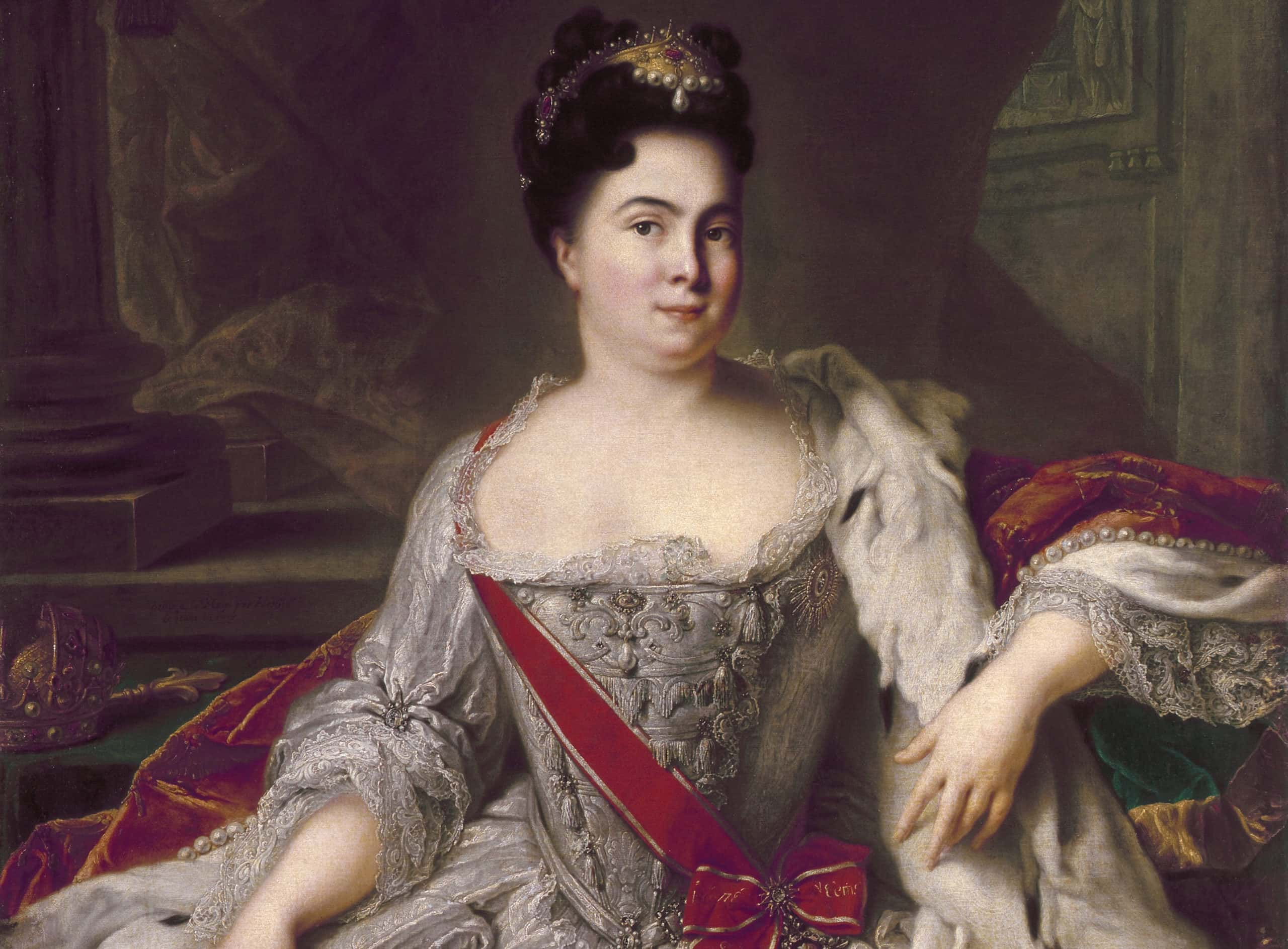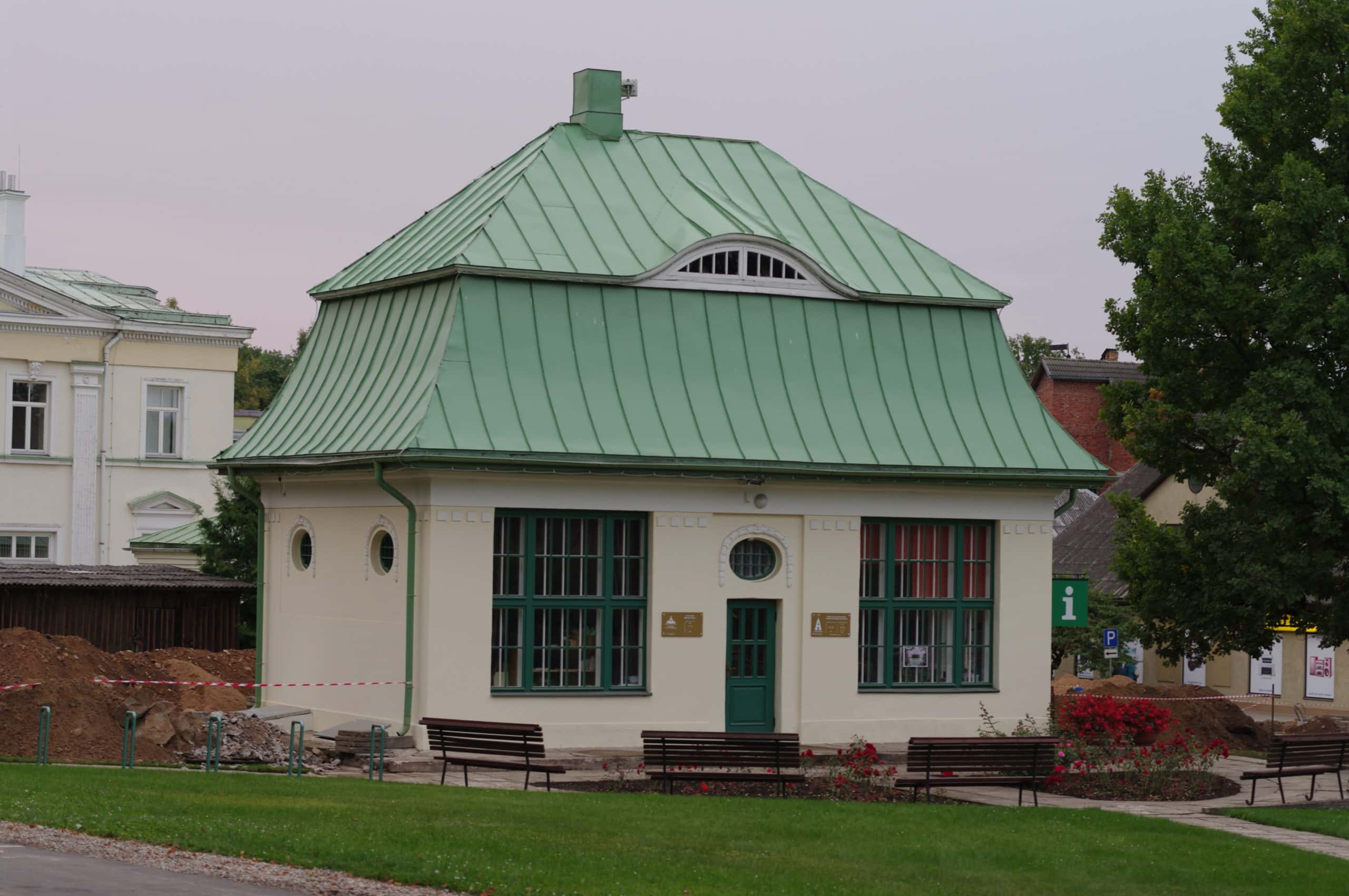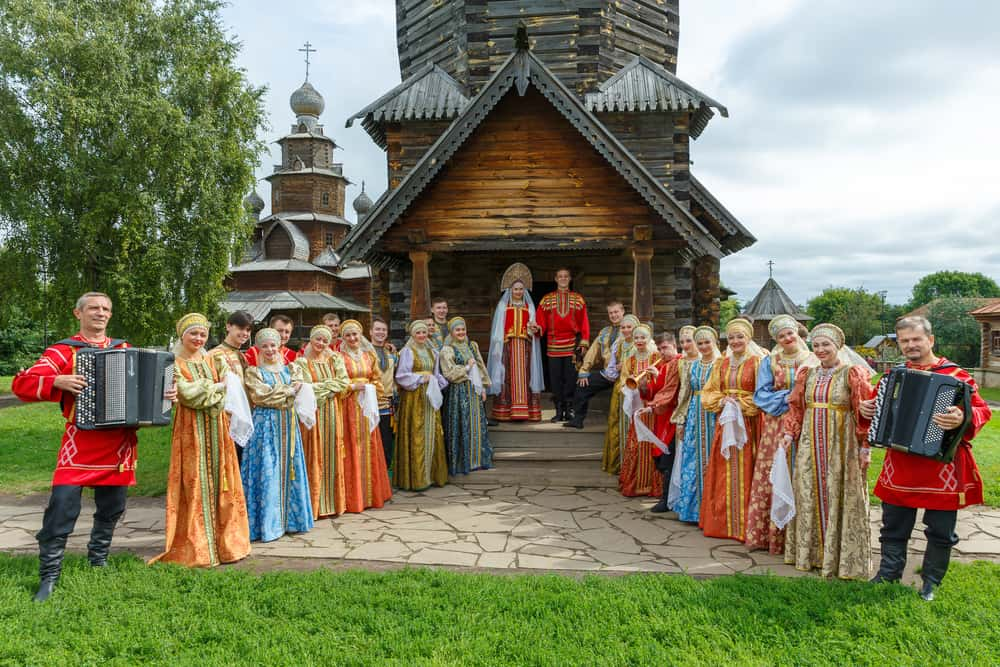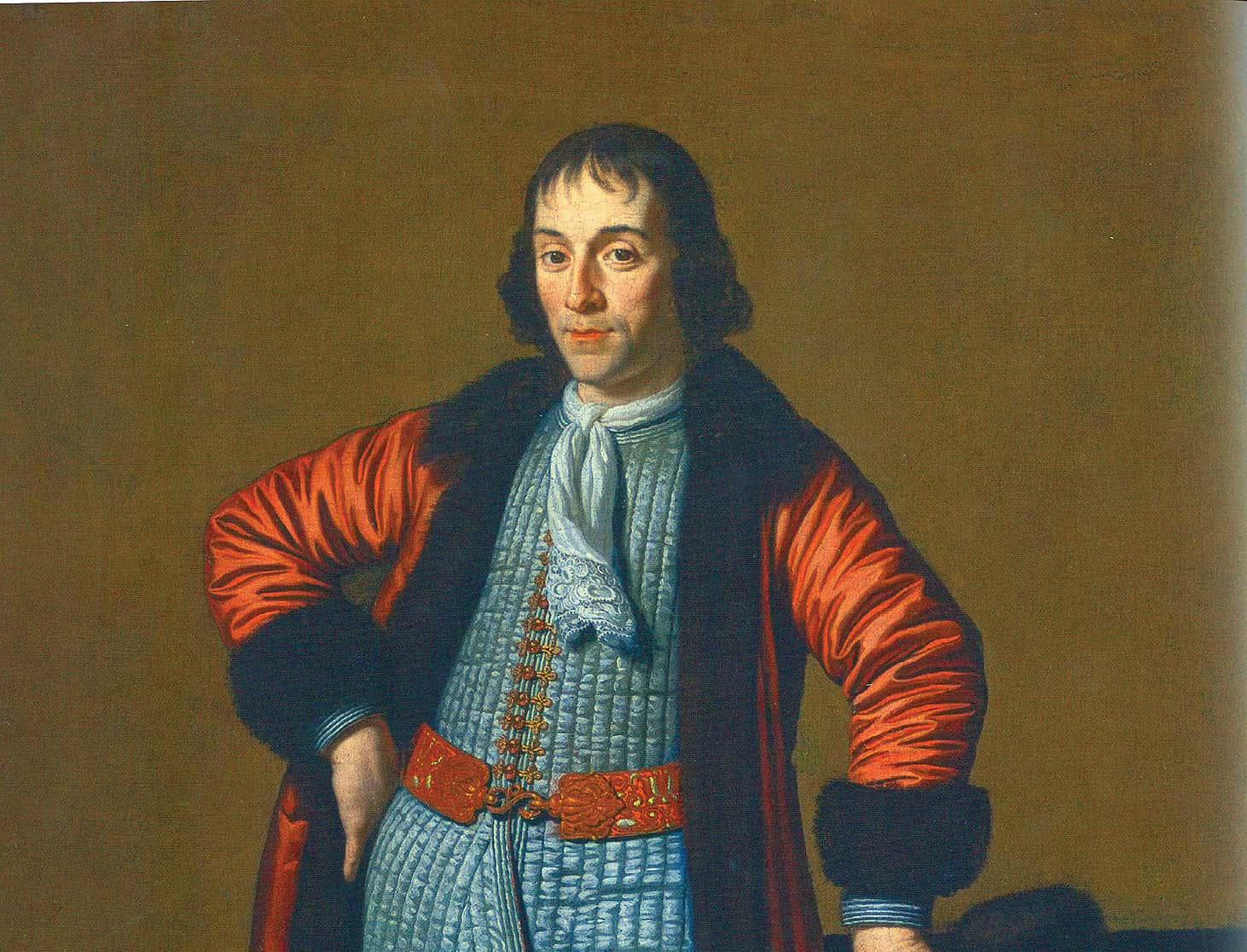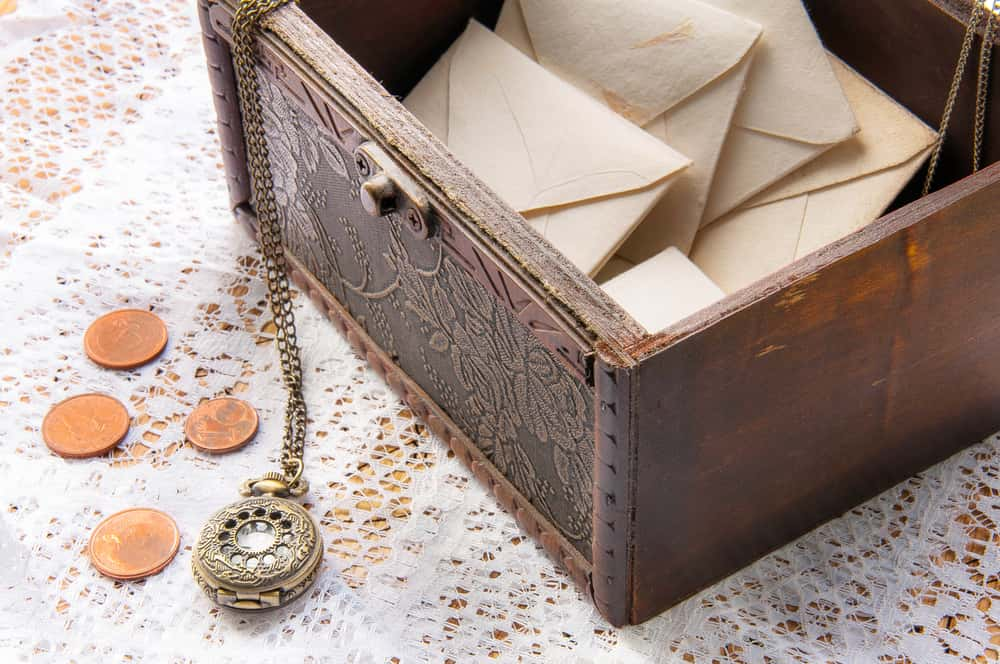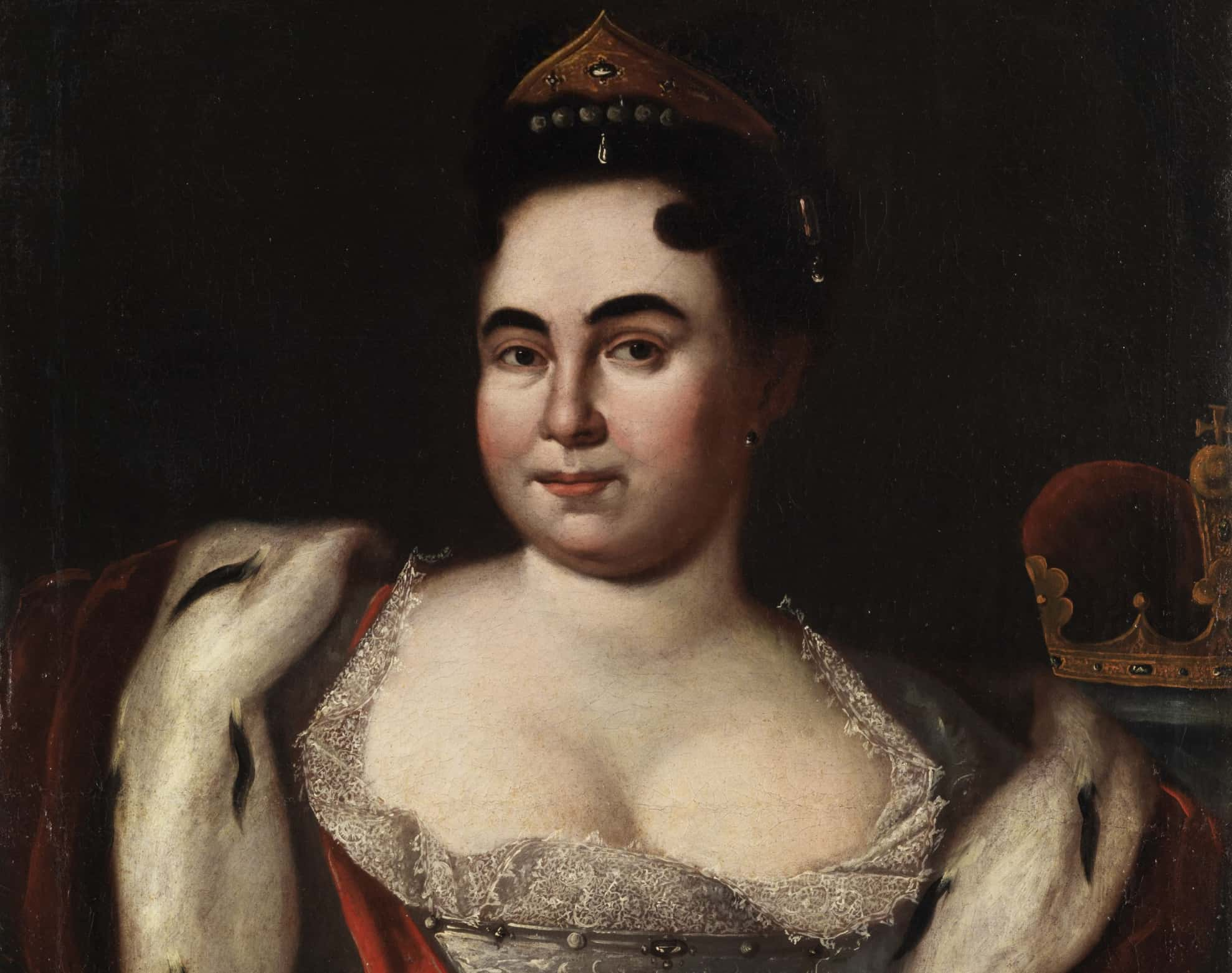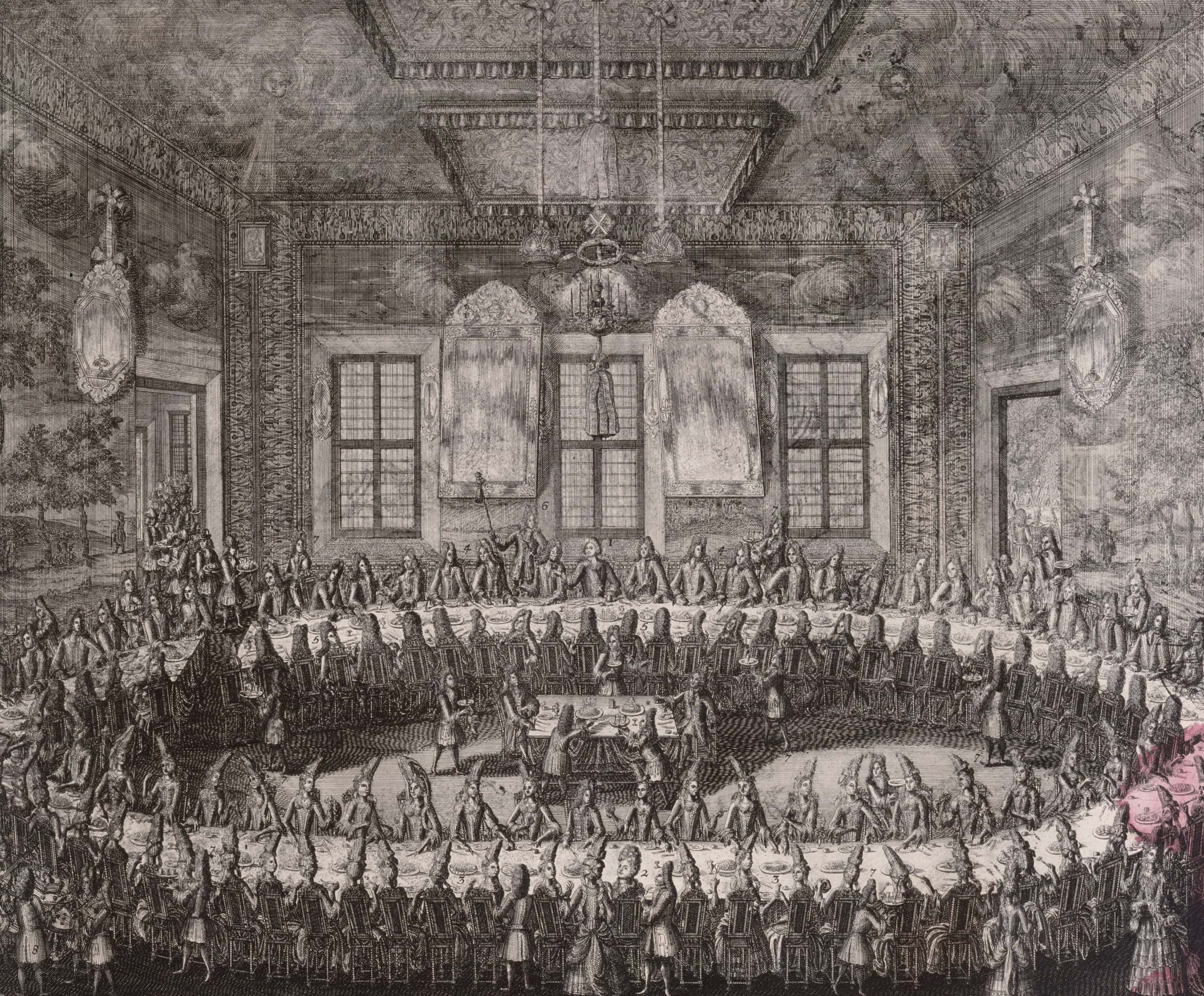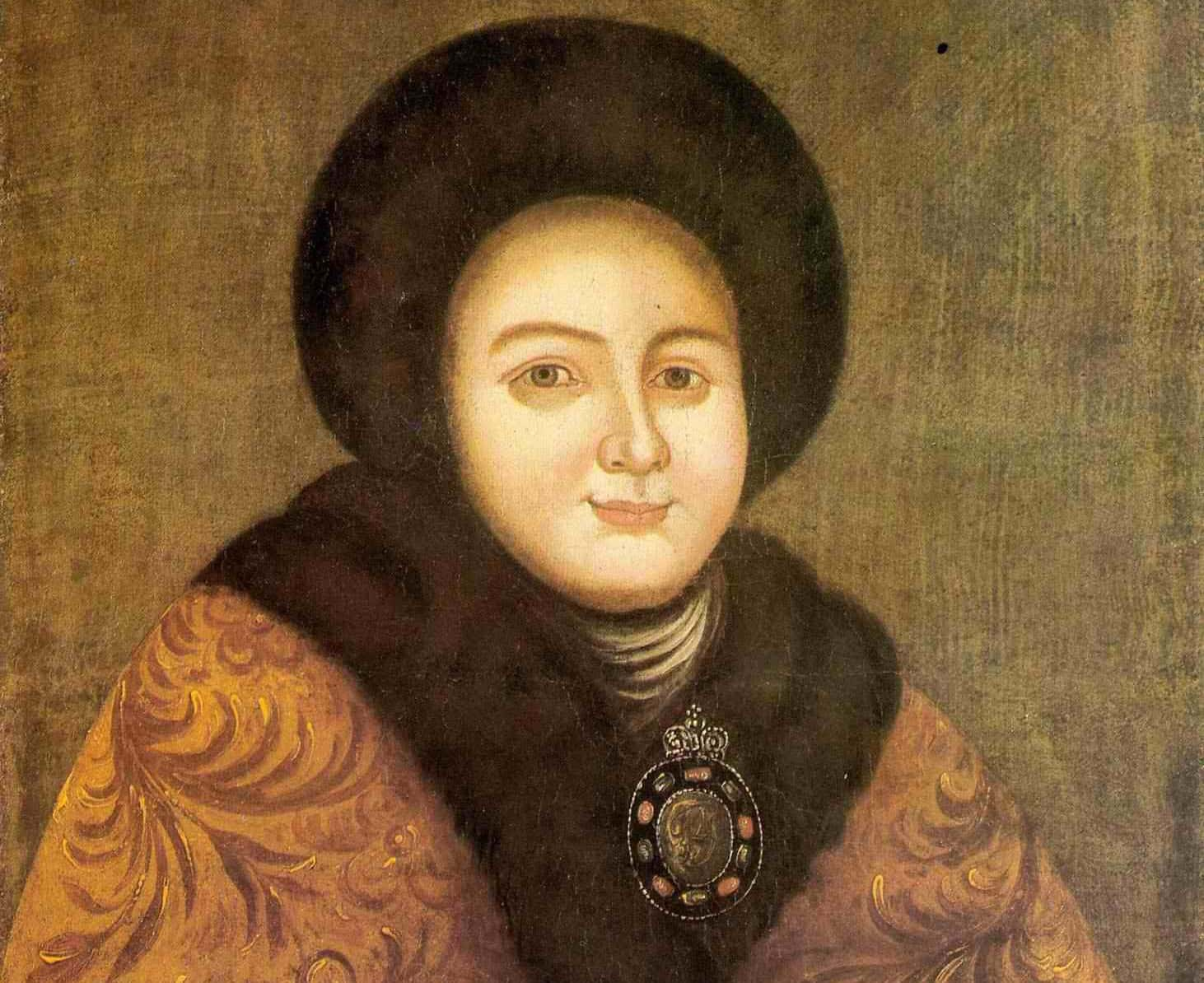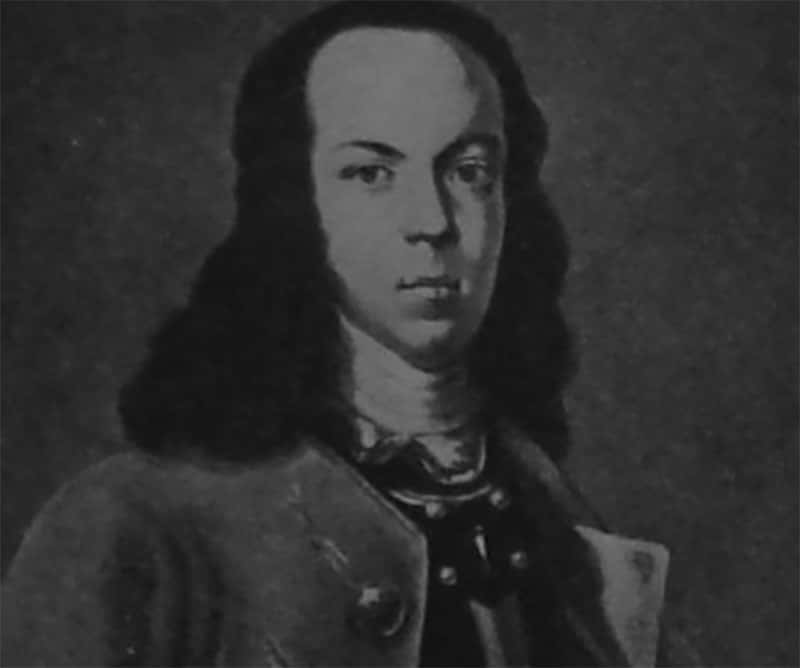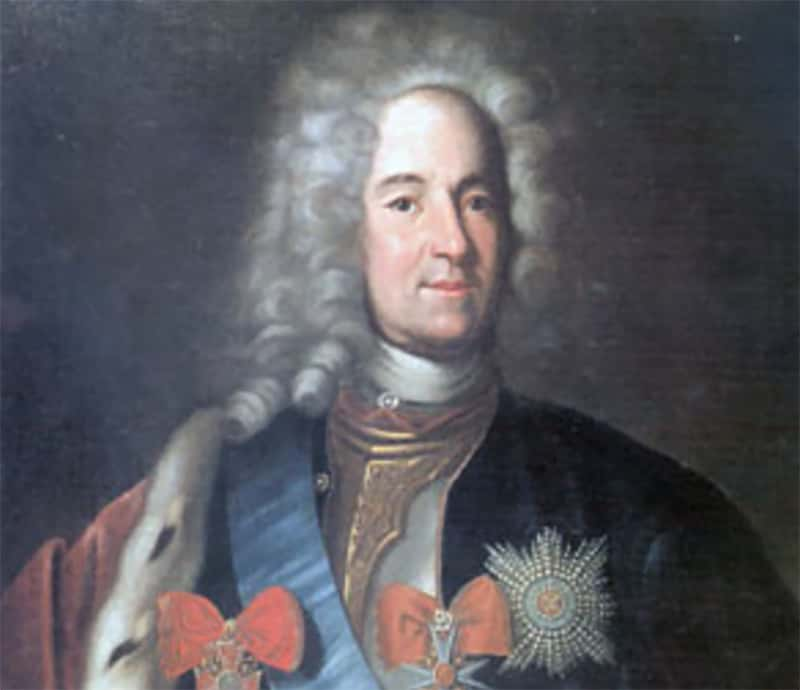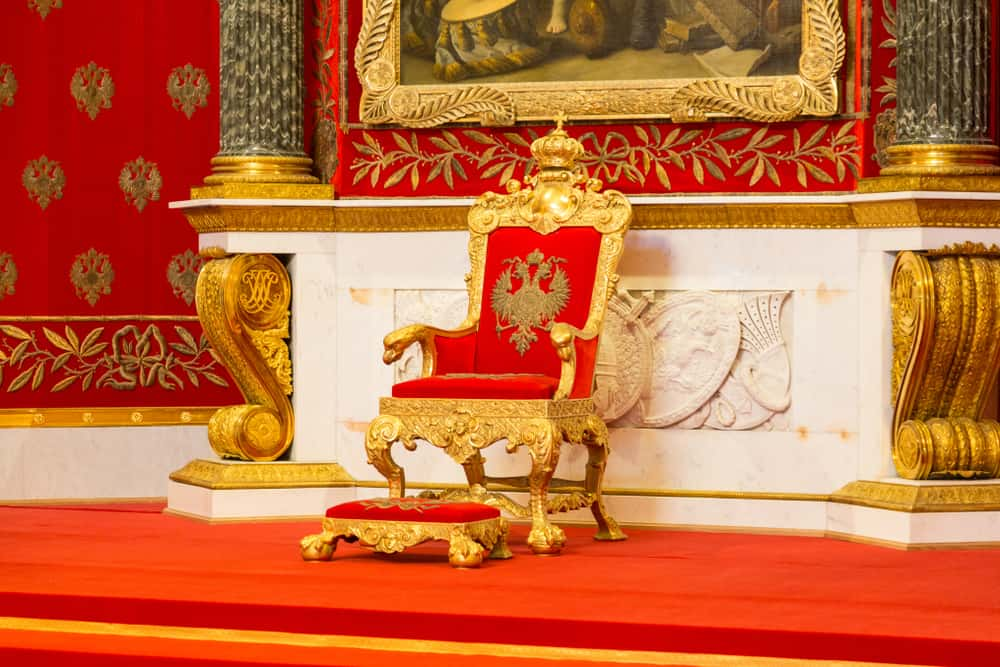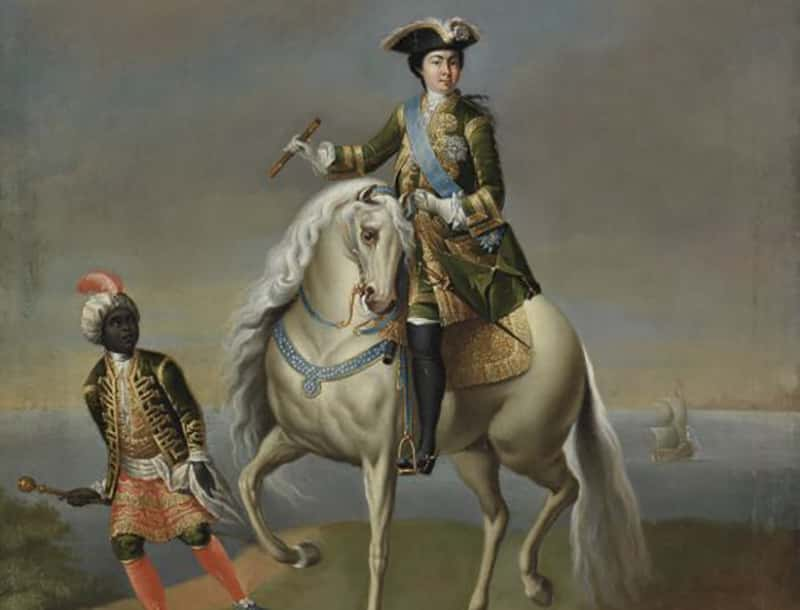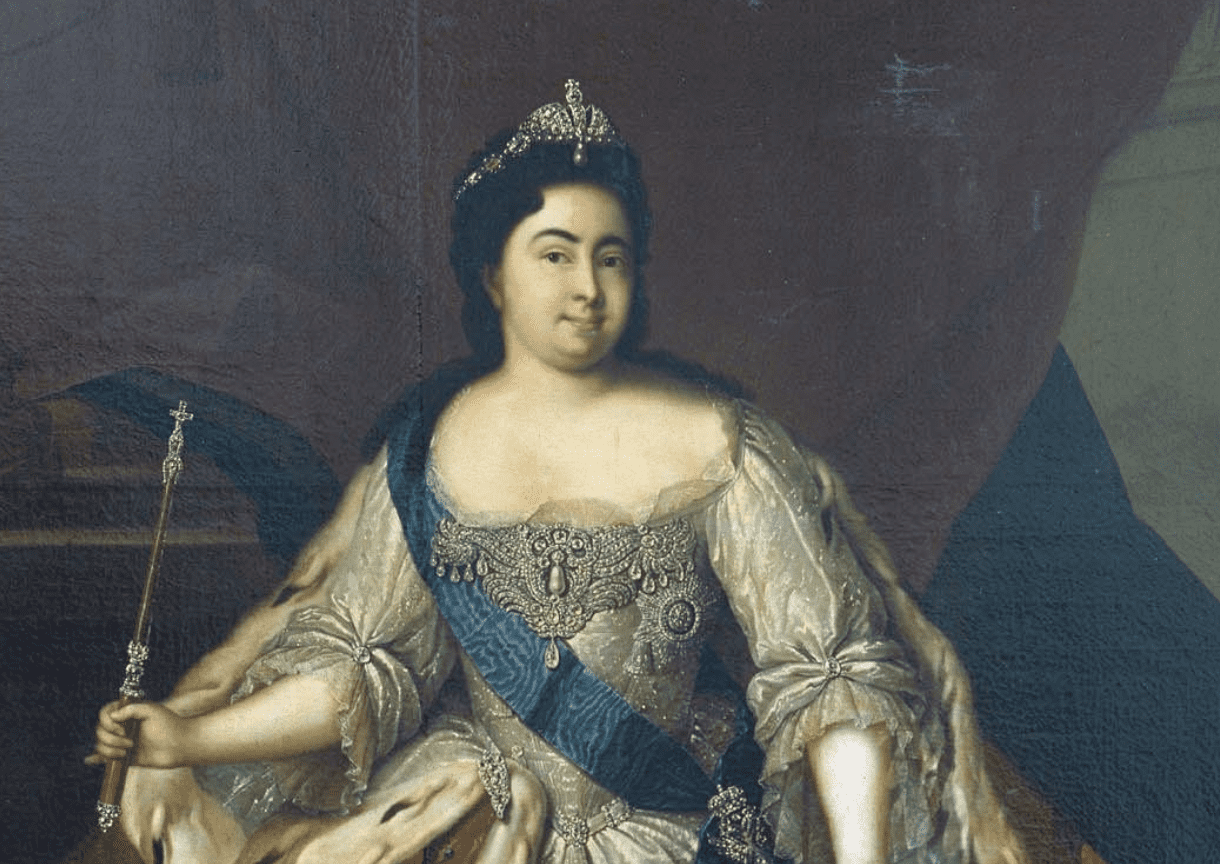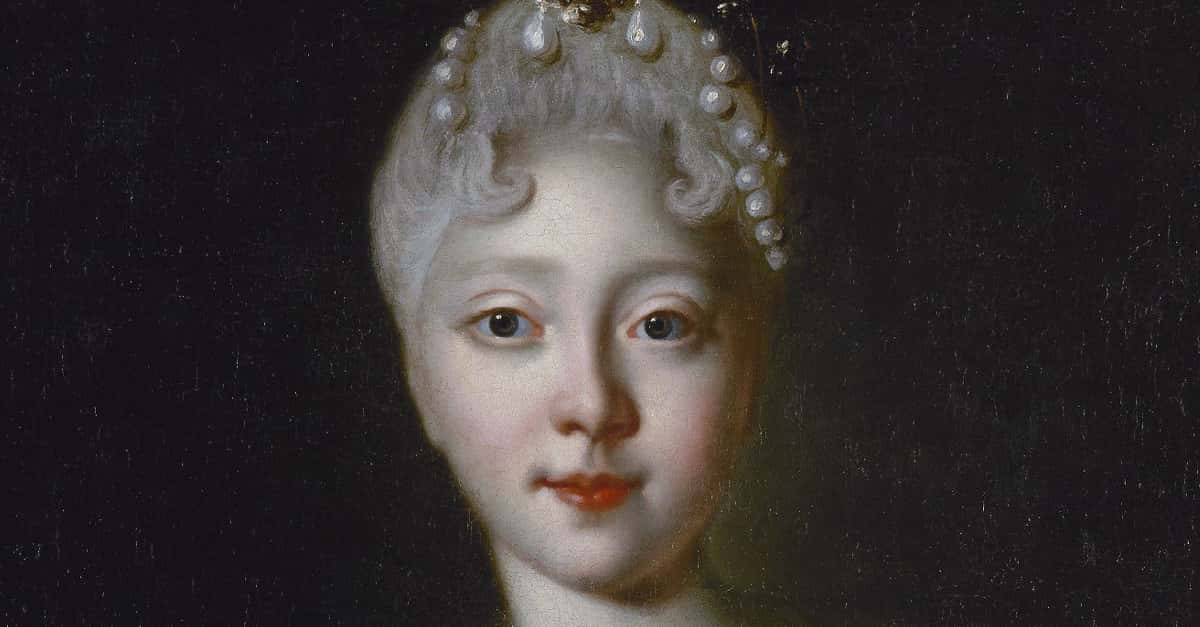The life of Catherine I was a true rags-to-riches tale. Born into poverty, her slow rise from the very bottom to the very top of the Russian Empire practically reads as a twisted Cinderella story come to life. Despite her dire beginnings, Catherine was beautiful, ambitious, and savvy—a triple threat—and she knew how to play the long game to get what she wanted…but at the end of the day, one could surmise that all she really wanted was to be truly loved.
1. She Began As A Peasant
Although Catherine I thrived in her adult life as an Empress of Russia, her early years began in poverty. Born Marta Helena Skowrońska in Swedish-controlled Latvia on April 15, 1684, she supposedly entered the world as the daughter of a Roman Catholic farmer. However, not all historians agree about her father’s exact profession: Some speculate that he might have actually been a gravedigger and a handyman, while others argue that he was really a “runaway landless serf”.
Either way, it’s safe to say that her chances at that point of reaching any level of power were close to nil. So what happened to change it all?
2. She Was An Orphan
It wasn’t an easy climb. Marta endured a start to life that was both rocky and heartbreaking. At the ripe old age of three, she and her four siblings tragically lost their parents to the plague and wound up residing with their aunt. Sadly, this new living arrangement didn’t last long, either. Instead of keeping Marta close by to raise herself, her auntie chose to send the poor toddler away to live in Marienburg, Latvia, with a Lutheran pastor named Johann Ernst Glück.
But Glück didn’t foster Marta out of kindness…
3. No One Educated Her
Now, one can assume that Marta’s aunt thought she was doing what was best for her niece by sending her to Glück because this guy was a really smart fella. He was an educator and the first person to translate the Bible into Latvian.
It undoubtedly stood to reason that his raising Marta would present her with a golden opportunity for some higher learning.
Regrettably, though, that wasn’t the case. Glück put exactly zero effort into educating Marta, and as a result, she remained illiterate for the rest of her life. Why?
Well, it turned out that he had other plans for her…
4. She Became a Servant
Glück never intended to educate nor raise Marta as his own, probably because he didn’t see the point in doing so. You see, Glück intended a life of pure drudgery for Marta; he’d taken her in not as a prospective daughter but as a prospective scullery maid or washerwoman. But seriously, who the heck uses a bereaved three-year-old as a servant!
?
That’s pretty cold-hearted. But as they say, the best revenge is living well…
5. She Was Attractive
Despite her rough start, as Marta grew older, she blossomed into a beautiful young woman. A natural blonde, she wore her hair long and loose over her shoulders. Additionally, the future empress supposedly sported “a lithe figure, a tilted nose, and velvety black eyes” and was considered by most to be quite the looker.
However, her appearance would later prove to be both an asset and a curse…
 Peter the Great (1986), NBC Productions
Peter the Great (1986), NBC Productions
6. The Pastor’s Wife Resented Her Appearance
Marta’s burgeoning good looks emerged to the great chagrin of Glück’s wife. The Glücks had a son, and according to some accounts, Mrs. Glück resented Marta’s beauty because—horror of horrors—her son might possibly maybe end up liking her. Obviously, it’d be unacceptable for Junior to become attracted to the help, so the Glücks hatched out a little preventative scheme…
 Peter the Great (1986), NBC Productions
Peter the Great (1986), NBC Productions
7. She Married A Soldier
The Glücks came up with a callous plan for poor Marta. They married the still-teenaged girl off to a Swedish dragoon.
Originally, the Glücks set a later date for Marta’s wedding; however, a growing conflict between Sweden and Russia totally disrupted the zen of their entire town and forced the wedding date forward. But sooner isn’t always better, and the marriage didn’t endure…
8. Her Husband Ditched Her
Marta’s matrimonial bliss didn’t last for long. The marriage lasted for exactly eight days before the Swedish army abandoned Marienburg.
So, following his latest marching orders, Marta’s new hubby unceremoniously took off and disappeared from her life forever…an action one might describe as being a serious “hit it and quit it” situation.
Yes, their union had been brief, but come on—not even a letter? Not cool, dude.
She didn’t have much time to grieve, as a disaster awaited her around the corner.
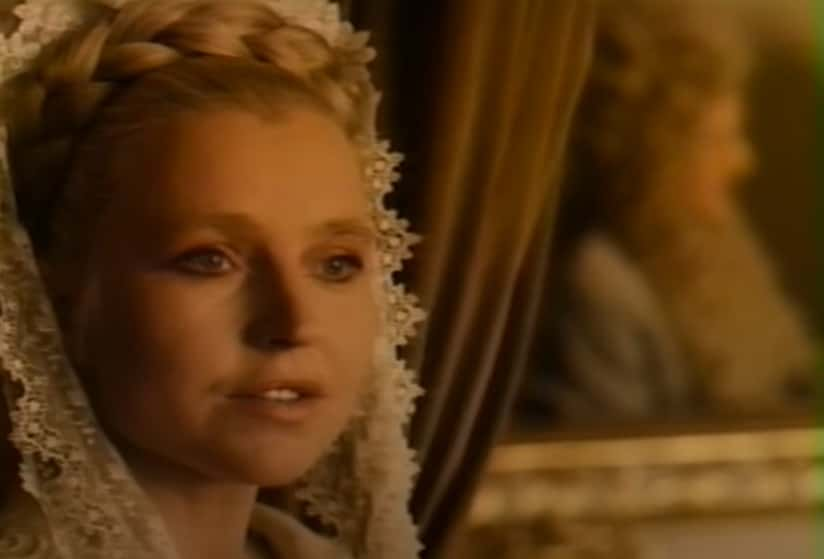 Peter the Great (1986), NBC Productions
Peter the Great (1986), NBC Productions
9. She Became A Prisoner
After the Swedish army’s withdrawal, the Russian forces captured the town of Marienburg, where Marta still resided with the Glücks. During this time, the Russians took Pastor Glück to work as a translator in Moscow, and Marta found herself briefly laboring for the conquering army, possibly as a laundress. So basically:
Same job, different employer.
She had no idea that her lot in life was about to change in a really twisted way…
 Peter the Great (1986), NBC Productions
Peter the Great (1986), NBC Productions

Sign up to our newsletter.
History’s most fascinating stories and darkest secrets, delivered to your inbox daily. Making distraction rewarding since 2017.
10. The Russian Court Passed Her Around
Again, Marta was a fetching young woman, so her looks quickly caught the attention of some of the higher-ups in the Russian army. Supposedly, while she served in the household of Field Marshal Sheremetev, he made Marta his mistress before he presented her in her undergarments to Brigadier General Adolf Rudolf Felix Bauer.
He also later dangled her before Prince Aleksandr Menshikov, the bestie of her future paramour, Peter the Great.
Yet, despite the unsavory nature of how they met, Marta’s relationship with Menshikov ultimately changed her fortunes forever.
11. She Gained An Ally…Sort Of
It’s hard to say whether Marta was ever really Menshikov’s mistress or not, but it is clear that they ostensibly became each other’s ride-or-die after she joined his household. An odd alliance, to be sure, but Menshikov was both clever and an opportunist; and he came up with a devious plan. He knew his royal best bud’s romantic tastes, and he believed Marta fitted them to a T.
He also enjoyed being in the tsar’s good graces. As such, a prime opportunity presented itself…
 Peter the Great (1986), NBC Productions
Peter the Great (1986), NBC Productions
12. She Became A Pawn
Menshikov was undoubtedly already aware that Peter shipped his first wife away to a convent and pink-slipped his mistress of 12 years, Anna Mons. As such, historians theorize that Menshikov planned to permanently secure Peter’s favor by presenting him with a mistress who’d always remain loyal to…well...himself.
Enter Marta.
If they played their cards right, Marta would become the new mistress to the Tsar of Russia—a BIG step up from the officers who kept sharing her—and Menshikov would win a permanent gold star from the tsar. It seemed like a win-win arrangement…but would it work out so easily?
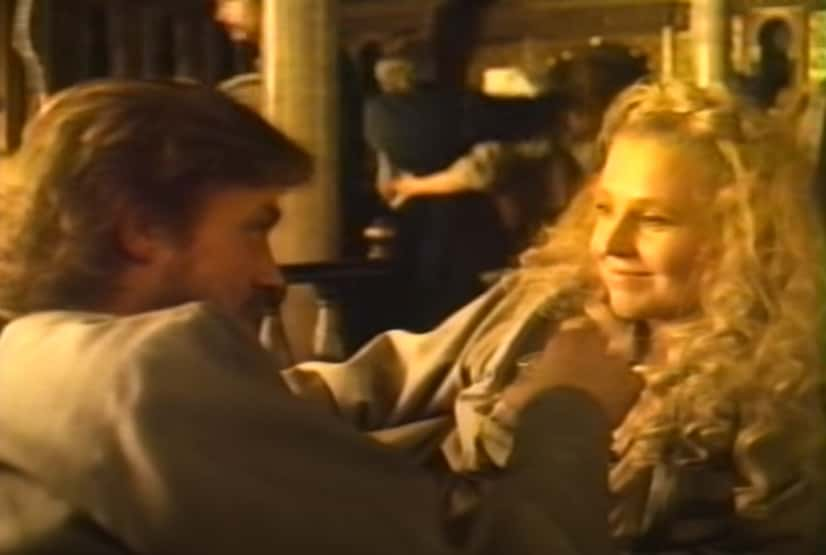 Peter the Great (1986), NBC Productions
Peter the Great (1986), NBC Productions
13. She Seduced The Tsar
Fortuitously, Marta managed to catch the tsar’s eye while serving him dinner at Menshikov’s house…and Menshikov noticed. He knew that this was their best opportunity.
So, milking her potential as his royal golden goose, he instructed Marta to, ahem, entertain the tsar by spending the night with him in his room.
Fortunately, her night with the tsar was a success. Maybe even too much of a success…
 Peter the Great (1986), NBC Productions
Peter the Great (1986), NBC Productions
14. She Charmed The Tsar
The plan worked perfectly. Marta enchanted him, and it was practically love at first sight for the tsar, who immediately became attracted to her alluring beauty, wit, and mannerisms.
In the end, Menshikov’s assessment of Marta was correct: To Peter, she was the whole package, and their pairing was a match made in heaven.
Suffice it to say, she had him at hello. Or at least, it seemed like she did.
 Peter the Great (1986), NBC Productions
Peter the Great (1986), NBC Productions
15. The Tsar Paid Her
Although it became clear after their fateful night together that the tsar really like-liked Marta, it didn’t stop ol’ Pete from committing a huge dating faux pas by today’s standards. When he left Menshikov’s house in the morning, he paid Marta a gold ducat for her “services”. Oof.
Way to make a lady feel special.
Fortunately (for him, at least), the tsar’s “payment” somehow didn’t turn Marta off. After all, she had her sights set on bigger things.
16. She Won The Tsar
Phase One of the plan was complete. Now, Menshikov needed to convince the tsar of Marta’s suitability to become his official mistress. So, Menshikov invited Peter back to his home.
After delaying Marta’s appearance to stoke the tsar’s anticipation, he eventually presented a richly dressed Marta in a satin gown and an over-the-top hairdo.
Her sophisticated new look did the trick: The tsar stayed for several days before sending his guards to whisk Marta away to his residence in Moscow.
Score. However, she didn’t stay for long in the lap of luxury…
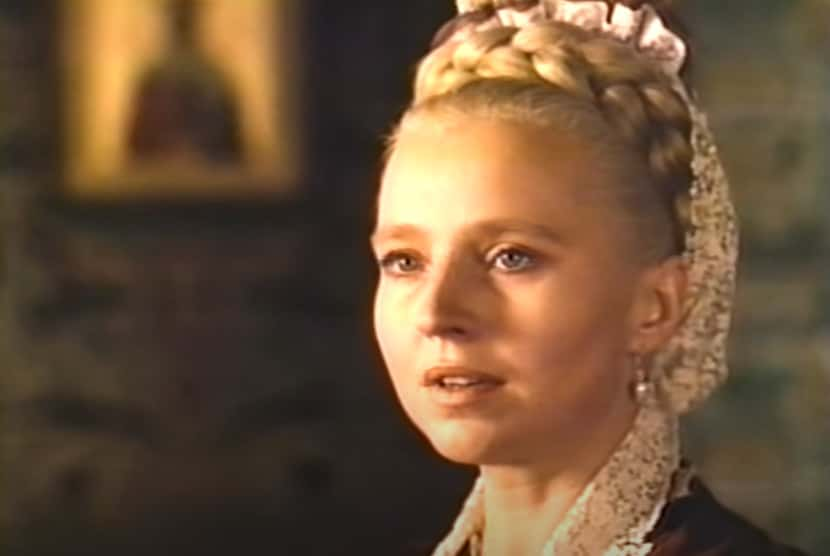 Peter the Great (1986), NBC Productions
Peter the Great (1986), NBC Productions
17. She Play-Acted An Ordinary Life
At the time, Peter was in the process of westernizing Russia, and he was still building his new capital city, St. Petersburg, when Marta came along. So, during the city’s construction in 1703, he and Marta opted to move into a modest three-room wooden cabin. Away from it all, they lived together as though they were any regular couple, with Marta handling all the cooking and (future) child-rearing while Peter peacefully tended to their gardens.
It was a domestic bliss that proved effective…
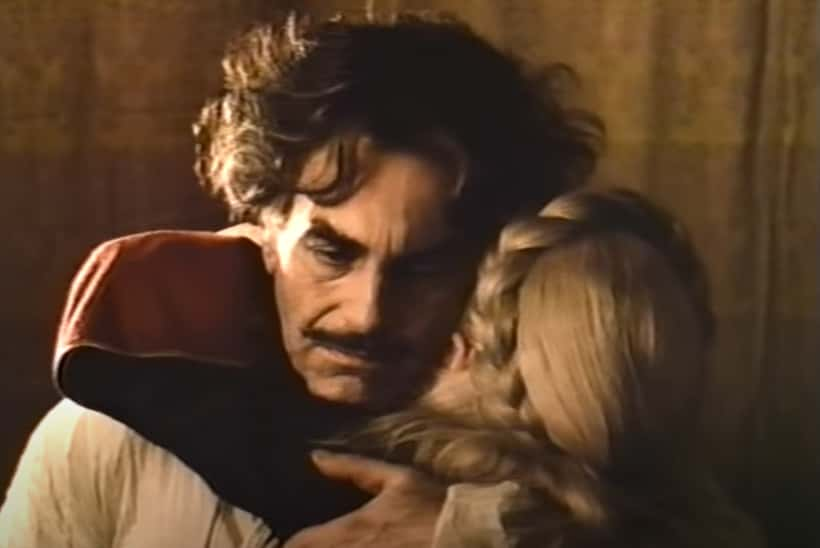 Peter the Great (1986), NBC Productions
Peter the Great (1986), NBC Productions
18. She Became The Tsar’s Official Mistress
By 1704, Marta was the tsar’s official mistress. No longer a servant nor a serial mistress, she now called one of the most powerful men in history her beau. She was in love, and even more incredibly, the tsar adored her back:
He doted on her, he wrote her innumerable love letters, and she wanted for nothing. Life was perfect…until it suddenly wasn’t.
19. She Lost Most Of Her Children
That same year, Marta gave birth to her first child, a son named Pyotr Petrovich, who sadly passed in his infancy. It was a heartbreaking loss, but sadly, it was just the start of Marta’s nightmare. Pyotr turned out to be only the first of many.
For the next several years, Marta continued to try for children, birthing 12 in total.
Only two managed to survive into adulthood: Grand Duchess Anna Petrovna and Grand Duchess Yelizaveta Petrovna. Motherhood wasn’t her only difficulty…
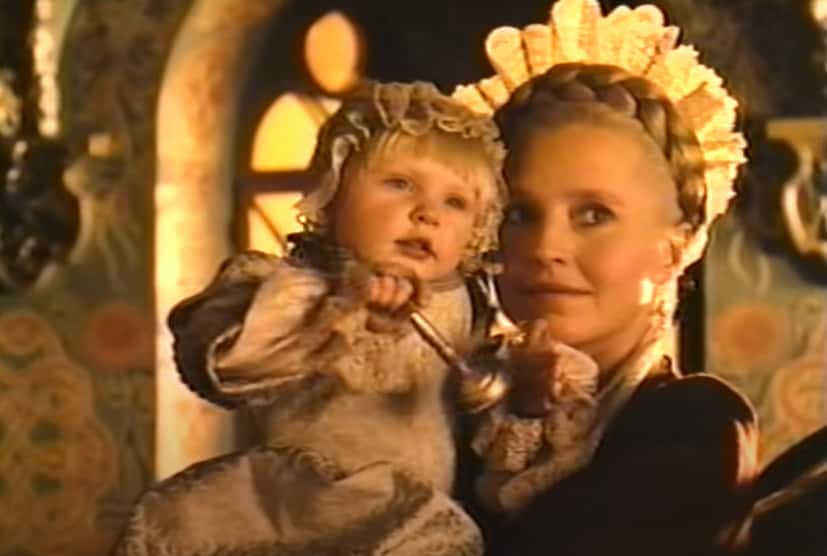 Peter the Great (1986), NBC Productions
Peter the Great (1986), NBC Productions
20. The People Didn’t Like Her
As much as the tsar cared for Marta, his subjects really did not.
In their eyes, she was little more than an obscure peasant girl who couldn’t read or write, so they didn’t understand her appeal as a mistress. In fact, the general conclusion was that Marta only gained her position by somehow bewitching the tsar. Sounds legit.
So, what could she do?
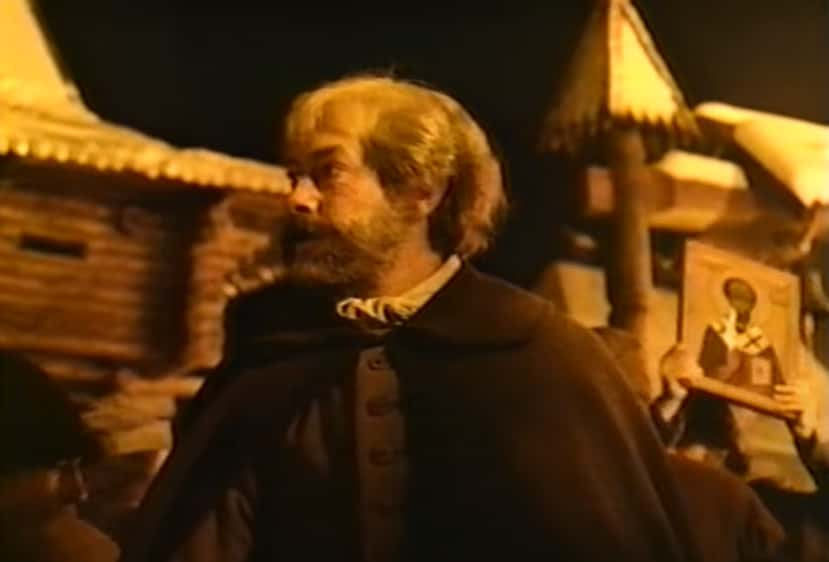 Peter the Great (1986), NBC Productions
Peter the Great (1986), NBC Productions
21. She Restyled Herself
Marta might not have won the heart of the public just yet, but she’d still do whatever it’d take to maintain her affection with Peter. How? Well, she did exactly what many modern women do when they want to shake things up a bit:
She dyed her hair. At some point, Marta began to color her naturally light locks black to visually differentiate herself from the tsar’s previous mistress, the also-blonde Anna Mons.
But she wasn’t done reinventing herself quite yet...
22. She Changed Her Identity
Sometime in 1705, she converted her faith to follow the Russian Orthodox Church and changed her name from Marta Skowrońska to Catherine Alexeyevna. With this outward transformation, the blonde beauty formerly known as Marta disappeared forever, and in her place now stood a dark-haired bombshell and future Empress of Russia.
Next, an internal transformation…
23. She Studied The Tsar
Catherine may have been uneducated, but she was far from stupid. Catherine excelled at emotional intelligence, and before long, she could read the tsar like a book. She devoted herself to understanding all of his moods, interests, and habits, and in doing so, she successfully endeared herself to him like no mistress before her.
Good thing, too, because her tsar-savviness became the very thing that ultimately made her indispensable to everyone...
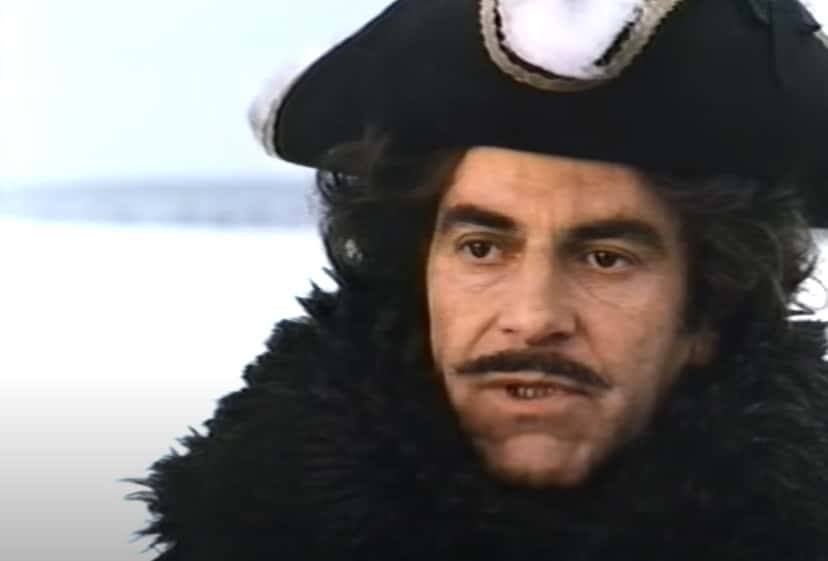 Peter the Great (1986), NBC Productions
Peter the Great (1986), NBC Productions
24. Her Lover Had Rage Issues
Catherine’s “Tsar 101” studies soon paid off in spades because, as it turned out, Peter had a terrifying dark side. He was prone to such frequent, brutal rages that he’d actually become a danger to those around him. But having studied him, Catherine always knew exactly what to do to calm him down, and she’d cradle his head in her lap until he fell asleep. Aww…
However, there was likely a dire reason for his overwhelming tempestuousness…
 Peter the Great (1986), NBC Productions
Peter the Great (1986), NBC Productions
25. Her Lover Had A Medical Condition
As much as the thought of a grown man raging like a lunatic might conjure the impression of a spoiled man-child, it turns out that Peter’s stormy disposition wasn’t entirely his fault. It’s important to note that during his fits, his eyes would pop out, and his entire face would violently twitch. Based on these accounts, historians believe that the poor guy likely suffered from some form of epilepsy.
Despite this unsettling twist in their relationship dynamic, the tsar still saw Catherine as the peanut butter to his jelly, so he finally took their relationship to the next level.
 Peter the Great (1986), NBC Productions
Peter the Great (1986), NBC Productions
26. She Married In Secret
In the end, the tsar’s heart won out over his head...kinda. Presumably, to dodge potential public backlash, Catherine and the tsar allegedly married in secret in Saint Petersburg sometime between October 23 and December 1, 1707, although no official record of these particular nuptials exists.
Take that, naysayers! Lovers: 1, Haters: 0.
But just because they’d tied the knot, it didn’t mean that everything was suddenly easy…
27. Her Marriage Stayed Hidden
As it turned out, the tsar still had his doubts. Peter worried that his publicly marrying Catherine would remind people of his ex-wife, Eudoxia. In comparison to Eudoxia, who was presumably educated and came from a minor noble family, Peter knew that Catherine’s illiteracy and lowly birth would’ve made her an unacceptable replacement tsarina in the eyes of the Russian nobility.
She’d have to do something…but what?
28. She Participated In Army Campaigns
Wanting to show her support for the tsar, Catherine started joining him on his military campaigns…alongside Menshikov and his wife, Darya. Yeah, AWKWARD.
Clearly, Catherine was one freakin’ ballsy lady because going on long and potentially dangerous excursions with a (secret) husband, a former secret lover (and co-schemer), and the former secret lover’s spouse was really tempting fate if you ask me.
But in the end, her participation was a good thing because one of those campaigns completely turned around Catherine’s negative public image.
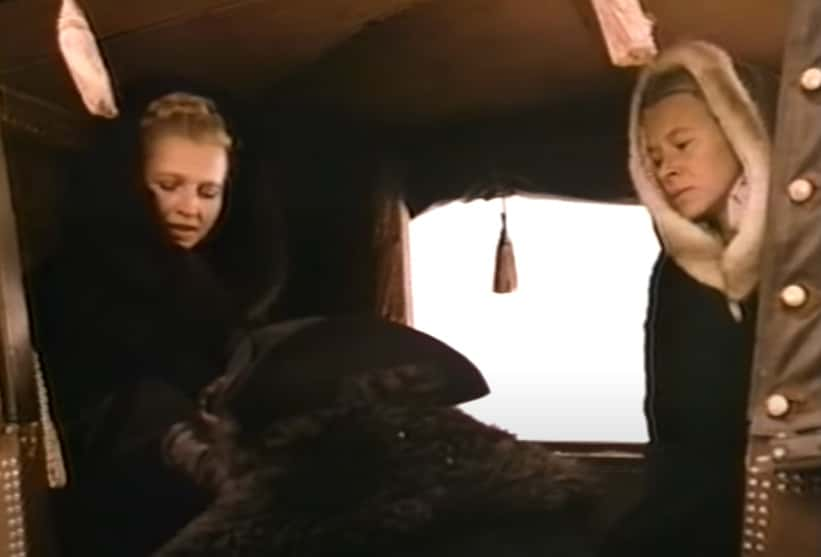 Peter the Great (1986), NBC Productions
Peter the Great (1986), NBC Productions
29. She Saved The Russian Army
As Catherine accompanied Peter on his Pruth Campaign in 1711, the Russian army landed in a sticky situation when the Turkish forces suddenly surrounded them.
With the tsar on the brink of surrender, Catherine thought fast: What could she do? Well, Catherine came up with an incredible plan. She cleverly thought that she and the other accompanying women could bribe the Ottoman grand vizier with their jewels to allow them to retreat.
Incredibly, the grand vizier accepted the offer. The Russians evaded capture, and Catherine saved the tsar and his kingdom. But was her deed great enough?
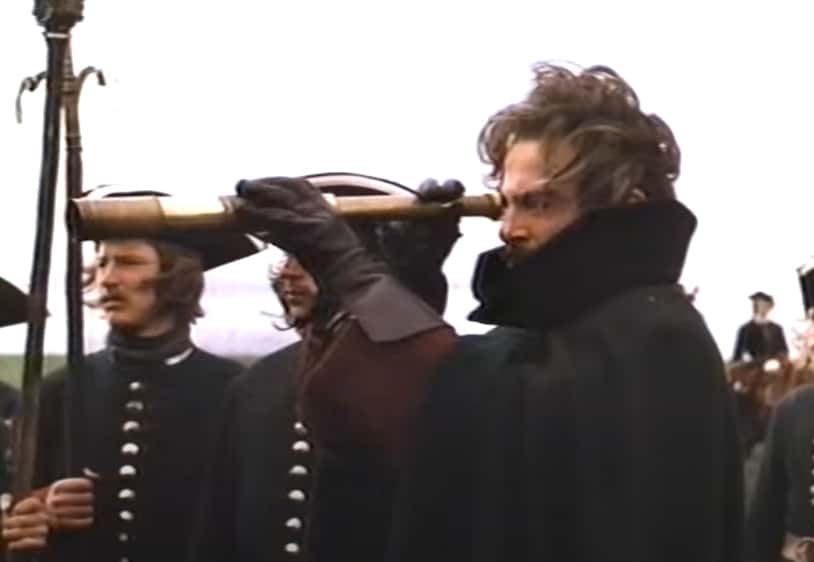 Peter the Great (1986), NBC Productions
Peter the Great (1986), NBC Productions
30. She Became A Tsarina
As it turned out, it was. Peter gave Catherine all the credit for saving his army, and the new praise was finally enough to sway the public’s opinion of her. At last, they could publicly wed.
The couple married (again) in St. Petersburg at Saint Isaac’s Cathedral on February 9, 1712, and she became the official Tsarina of Russia.
At last, Catherine reached the top…but the real work was just beginning.
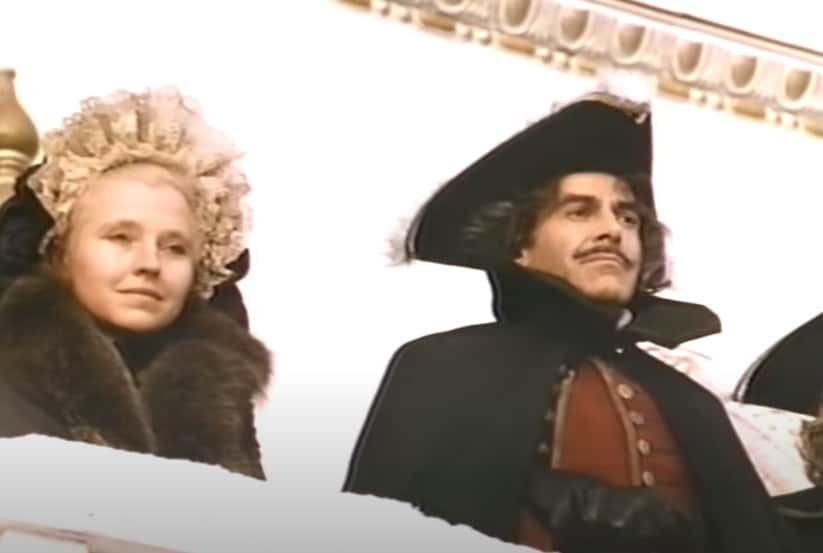 Peter the Great (1986), NBC Productions
Peter the Great (1986), NBC Productions
31. She Lived Cautiously
As the new tsarina, Catherine likely had to tread very carefully. After all, her “low-born” self only just barely managed to grab onto the royal title. Now, she had to keep it.
Fortunately, Catherine wielded much more staying power than her failed predecessor. How? Well, it seems like she did it purely by existing in survival mode.
She only advised her husband when asked, she rarely disagreed with him, and she NEVER pursued any kind of aspiration, political or otherwise.
In essence, Catherine lived only to please her husband. But not everyone felt the same…
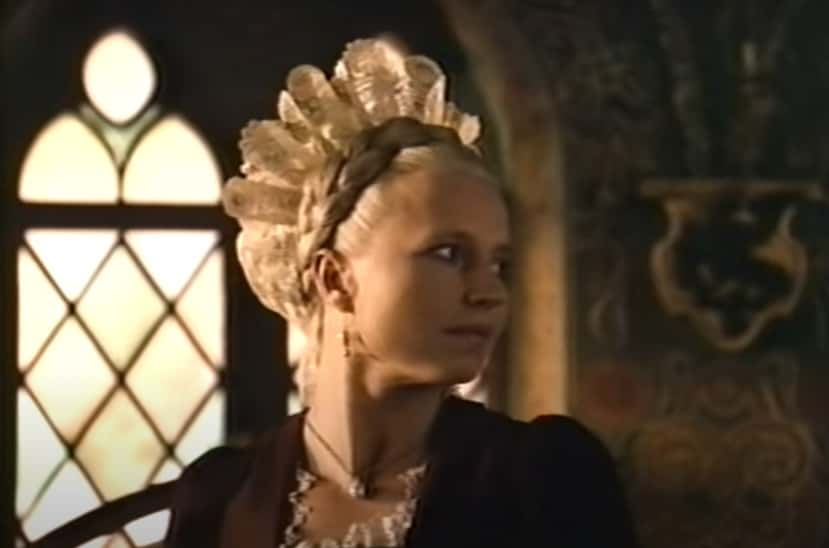 Peter the Great (1986), NBC Productions
Peter the Great (1986), NBC Productions
32. She Begged For Her Stepson’s Life
Peter’s and Eudoxia’s eldest son, Alexei, grew up to become a pretty disgruntled guy. Despite being Peter’s heir apparent, he contributed to a plot to overthrow his father and stepmother. However, they caught Alexei, and under extreme duress, he confessed to his involvement.
Catherine’s reaction was jaw-dropping. She pled with Peter to spare his son’s life.
Sadly, Alexei died in prison before his execution date. Soon, Catherine begged her husband for mercy, again…
33. She Kept Bad Company
Okay, so Catherine’s lady-in-waiting, Mary Hamilton, was a seriously messed-up person. She committed a laundry list of transgressions against the tsarina, including stealing Catherine’s jewels, starting a rumor that Catherine ate wax, and sleeping with Catherine’s husband. The tsar ultimately had Mary executed for her transgressions in 1719, but not before Catherine inexplicably begged him to spare her life, too.
In any case, Mary’s sabotage didn’t keep Catherine down, as there were much more important manners to attend to.
34. She Became An Empress
Having executed his only son and heir, Peter, who’d since become the Emperor of Russia, suddenly realized that he had a major problem: Who would inherit his kingdom?
He still had a living grandson, but the tsar did NOT want his treasonous son’s kid to succeed him. So, Peter decreed that Russian rulers could appoint their own heirs in 1722 before elevating to empress-consort and naming her Empress Catherine I in an elaborate ceremony.
Now, Peter technically never formally proclaimed his heir-apparent, but Catherine’s promotion was obviously a giant public hint. Unfortunately, all did not stay well between the loving couple…
 Petr Pervyy. Zaveshchanie(2011), Studio 2-B-2 entertainment
Petr Pervyy. Zaveshchanie(2011), Studio 2-B-2 entertainment
35. She Trusted The Wrong People
Remember Peter’s former mistress, Anna Mons? Well, at the time, her sister, Matryona Balk, was serving as a lady-in-waiting for Catherine while their brother, Willem Mons, was Catherine’s private secretary and an old friend of the royal couple. Catherine had little idea there were snakes hiding in her midst.
The siblings quickly realized that they could control who had access to Catherine. So, they began “selling” access to the royal couple…
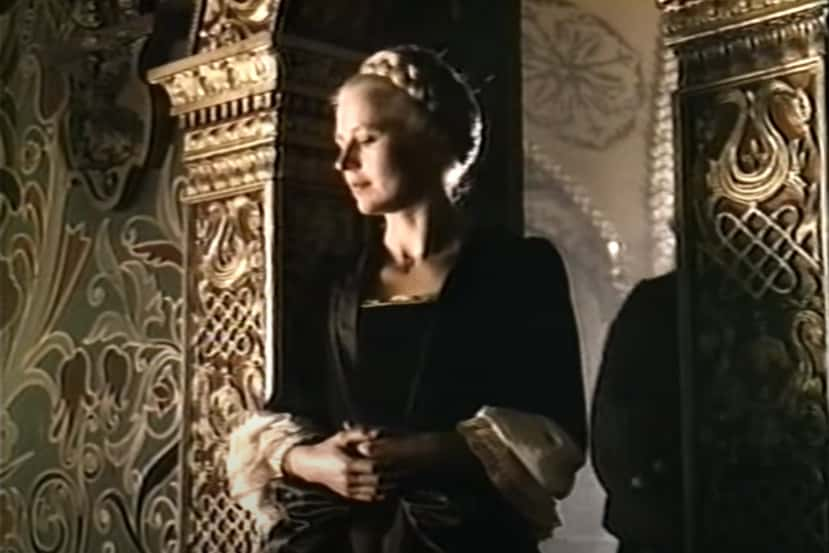 Peter the Great (1986), NBC Productions
Peter the Great (1986), NBC Productions
36. She Fell Out With The Tsar
Naturally, this outraged Peter when he found out. Catherine didn’t know what the siblings were up to, of course, but Peter worked his entire life to rid Russia of corruption, only to discover it happening right under their noses. The revelation of their friends’ betrayal sparked a giant fight between Catherine and Peter, and the couple refused to speak to one another for several months.
Why?
Well, it turned out that there was more to the story.
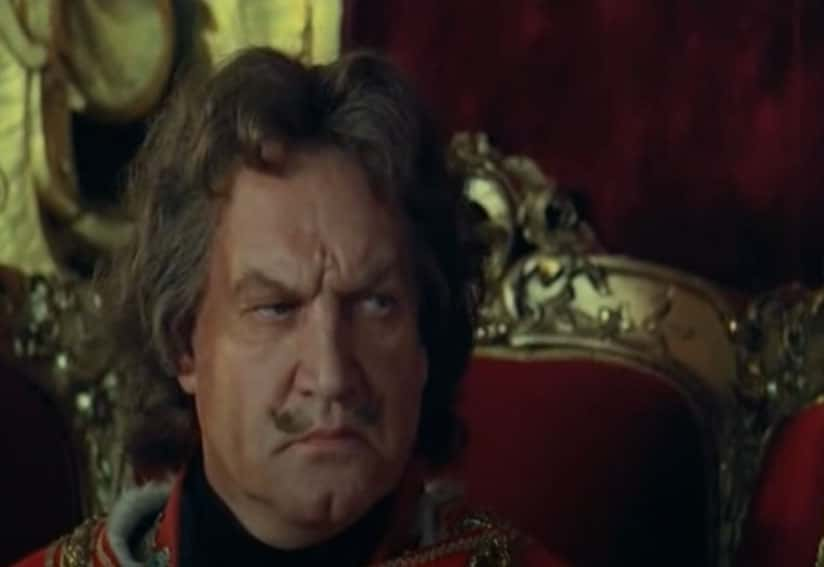 Tsarevich Aleksey (1996), Vitaliy Melnikov
Tsarevich Aleksey (1996), Vitaliy Melnikov
37. She Reportedly Had An Affair
Willem’s treachery allegedly ran much deeper than just selling access to the Russian rulers—and it was rumored that he and Catherine were hiding a dark secret. After officials caught the siblings, a rumor began circulating that Willem and Catherine were having an affair, and the chatter of it was apparently enough to make Peter’s head explode.
As a result, the duplicitous duo received very disparate punishments:
The emperor exiled Matryona, and—with no evidence to support the gossip—he executed Willem. Next, the emperor tried to punish Catherine.
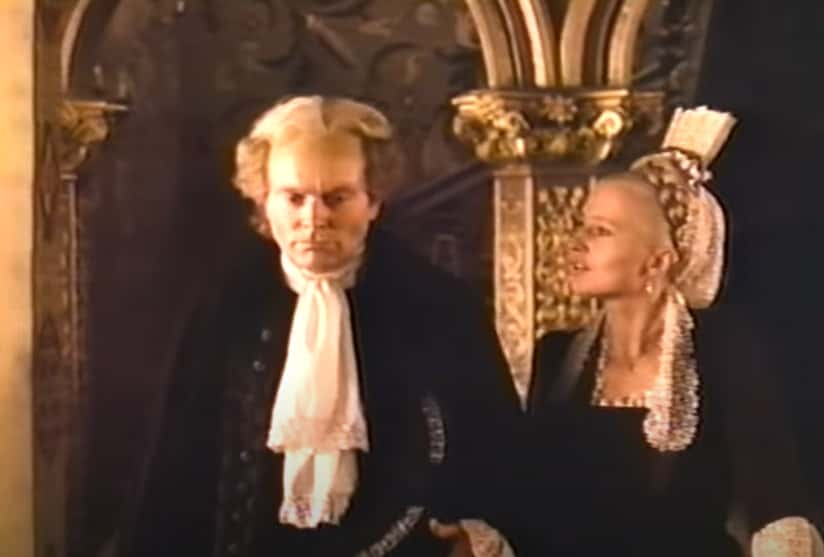 Peter the Great (1986), NBC Productions
Peter the Great (1986), NBC Productions
38. The Emperor Tried To Torment Her
On the day of Willem’s beheading, Catherine kept her composure, but Peter was still livid. Determined to crumble his wife’s good spirits, he deliberately walked her past the site of Willem’s execution to view their former friend’s severed head. Dark. Only, Catherine didn’t react in the way that Peter expected. Instead, she reportedly appeared completely unfazed, glanced down, and calmly remarked, “It’s a shame chamberlains have so many vices”.
Then, Catherine’s life took another sad turn.
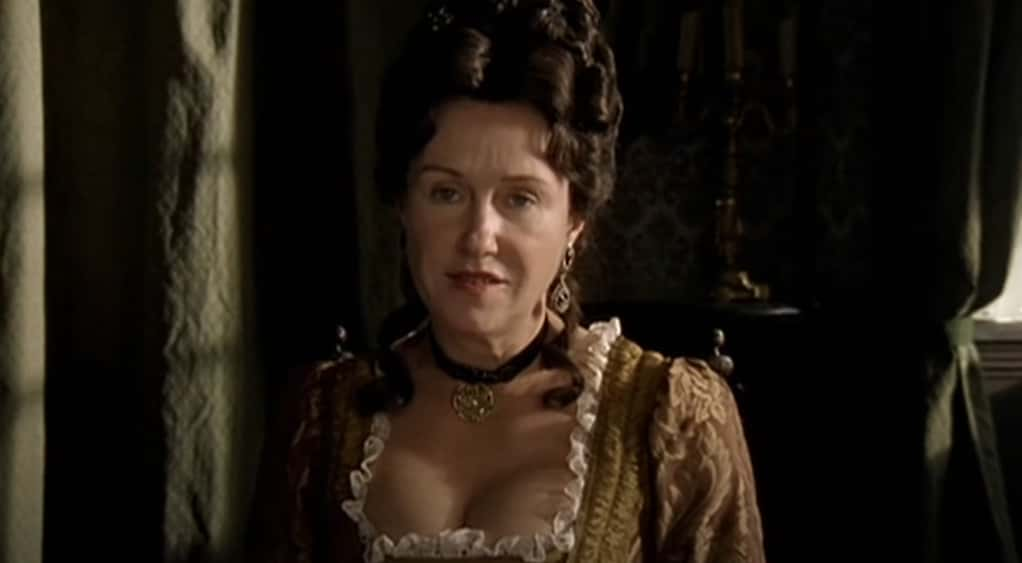 Petr Pervyy. Zaveshchanie(2011), Studio 2-B-2 entertainment
Petr Pervyy. Zaveshchanie(2011), Studio 2-B-2 entertainment
39. She Became A Widow
Things stayed icy between Catherine and Peter for a while after Willem’s execution, but they eventually reconciled. Unfortunately, Peter had fallen very sick at that point, as he suffered from recurring bladder and urinary tract problems.
He died on February 8, 1725. According to legend, he left a partially written note that read: “Leave all to…”
Whoever Peter meant to name remains unknown, but in any case, Catherine was ready to take the reins…
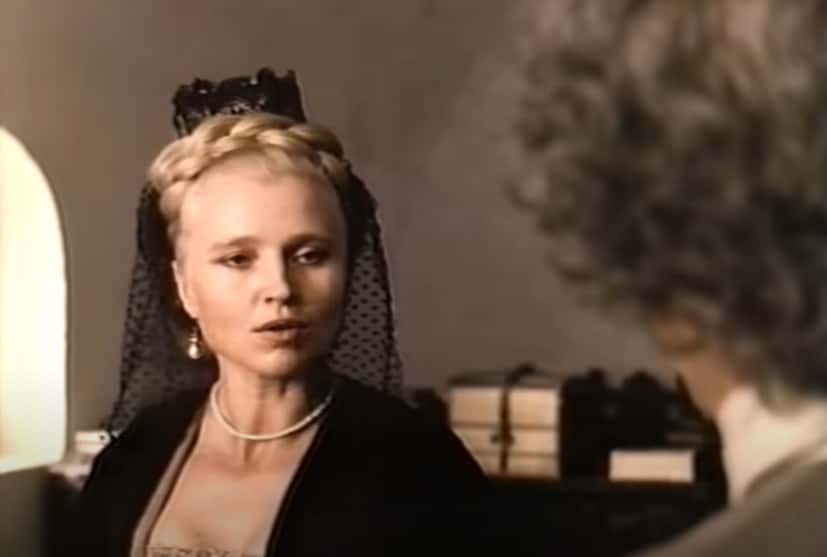 Peter the Great (1986), NBC Productions
Peter the Great (1986), NBC Productions
40. She Became The New Regent
Because Peter failed to name a successor before he passed, Russia’s remaining higher-ups convened a council meeting to choose a new ruler. Once again, Menshikov (yep, he was still lurking around) recognized and seized yet another opportunity:
During that meeting, he and a few others staged a coup to bring Catherine to power…and it worked.
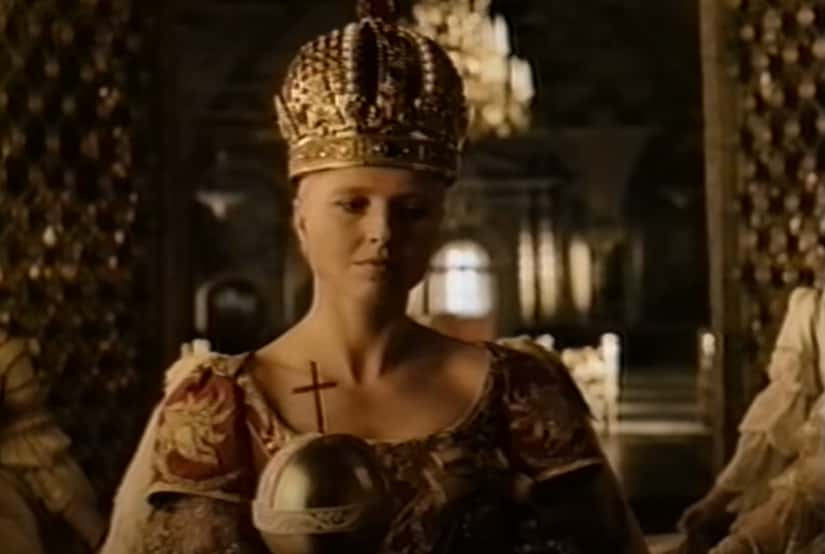 Peter the Great (1986), NBC Productions
Peter the Great (1986), NBC Productions
41. She Made Herstory
The guards all greatly respected Catherine, so no one stopped Menshikov’s coup, and Empress Catherine I emerged victoriously. Her rise was historically significant: She’d become the first woman to rule Imperial Russia, which subsequently set a major legal precedent for other women to rule after her. In fact, for the next century, women almost entirely dominated the empire’s regency.
However, that’s not to say that Catherine never viewed other women as potential threats…
 Petr Pervyy. Zaveshchanie(2011), Studio 2-B-2 entertainment
Petr Pervyy. Zaveshchanie(2011), Studio 2-B-2 entertainment
42. She Imprisoned Her Late Husband’s Ex
Peter already lost his first son to treason, but his ex-wife, Eudoxia, was still very much alive and kicking.
And now, she was a major threat to Empress Catherine I. Previously, several church officials supported Eudoxia in opposition to Peter’s reforms; they even sermonized her as their “great sovereign” until Peter executed them and had her confined to a convent. But once Peter died, the gloves came off, and Catherine secretly imprisoned her in Shlisselburg Fortress.
And Catherine wasn’t the only one experimenting with her newfound authority…
43. Her Advisors Took Advantage Of Her
Truth be told, while she did exercise her power from time to time, Empress Catherine didn’t really desire to rule. Her literacy hadn’t remarkably improved, and her noble supporters were all very much aware of that fact. Instead, the real power laid with her chief advisor, Menshikov, and the rest of her Supreme Privy Council, who were likely all counting on the fact that Catherine would act more as a figurehead and play no real role in governing the empire.
However, there were dark consequences to her complacency.
44. Her Government Was Corrupt
The establishment of the Supreme Privy Council of Imperial Russia ended up having quite the domino effect on the governance of the empire. With Catherine’s advisors handling all of the major decisions, the Senate’s role fell by the wayside, and her late husband’s reformist activities went neglected. Worst of all, the very corruption that Peter the Great had so despised returned in full force, and practices of bribery and embezzlement became rampant.
But it’s hard to say whether Catherine even noticed, because she had other priorities…
45. She Located Her Lost Siblings
By this point, her former peasant life as Marta Skowrońska must have seemed like a distant memory, but still…it was a memory that persisted. After all, Empress Catherine hadn’t seen her family in years, and it was high time she returned to her roots. After a search, she miraculously managed to locate all four of her long-lost siblings and bestowed them with titles, making them counts and countesses.
With that hole in her heart healed, Catherine began to enjoy her life a little more…
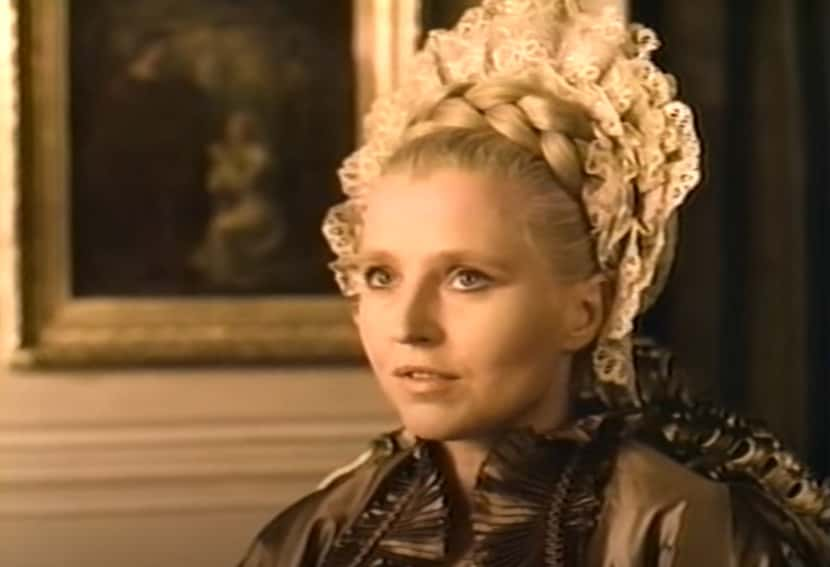 Peter the Great (1986), NBC Productions
Peter the Great (1986), NBC Productions
46. She Had An Odd Nickname
As mentioned earlier, Catherine had an excellent calming effect on the tsar, and Peter…well, let’s just say he was well aware of it. You see, Catherine consoled him, she cradled him, she rocked him to sleep—kind of like a MOTHER—and Peter knew it. In fact, he often acknowledged that his mistress acted as a mother to him…but that’s not the worst part. Sometimes, he openly referred to her by the shudder-inducing nickname, “Mother”. Ew.
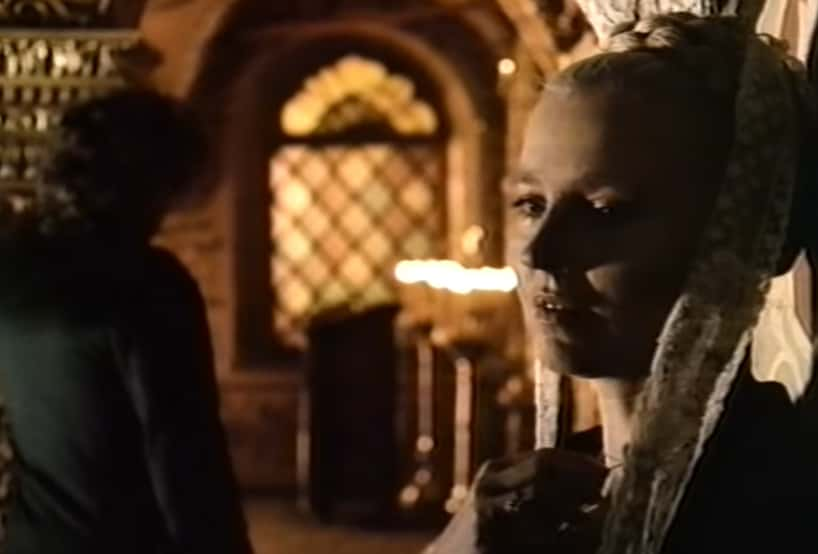 Peter the Great (1986), NBC Productions
Peter the Great (1986), NBC Productions
47. She Became Very Vain
Empress Catherine knew that her royal role came with mundane obligations, such as attending meetings and signing whatever documents her advisors put in front of her. But it also came with a lot of perks, like attending banquets, balls, and parades. Before long, Catherine developed a massive taste for luxury and began to self-indulge, spending small fortunes on clothing, barges, coaches, and palace upgrades.
She also liked to party...
48. She Started Drinking
With her advisors handling the bulk of the work, Empress Catherine, probably at loose ends, formed a bad habit of imbibing throughout the day. According to historian Evgeniy Anisimov, Catherine’s primary occupation involved “life wasting”. At the same time, the French ambassador, Jacques de Campredon, wrote that Catherine’s preferred avocation consisted of “almost daily drinking parties” that “last all night and a good part of the day”.
Regardless, the party-hardy empress was still widely supported…
49. The People Loved Her
In a complete 180 from where she first began, the Russian people grew to respect their empress.
Catherine had a keen understanding of the plights of the common folk—having lived them herself—and she always remained generous and kind to them. She often gave money to the poor and widowed brides, and she acted as the godmother of many peasant children. She also reduced the empire’s army expenditures, which resulted in lowered taxes for the common folk.
The people loved her, but tragically, she didn’t reign for long…
50. Her Final Wishes Were Suspicious
Just two years after losing her husband, Catherine died from tuberculosis at the age of 43.
But before she passed away, she supposedly named Peter the Great’s grandson, Peter II, as her successor, despite it being contrary to her late husband’s wishes. As such, historians have made a shocking accusation. They suspect that someone forged her final testament.
In truth, they think Catherine actually favored her daughter, Anna, to replace her but that Menshikov (that guy, again) and her other advisors managed to “persuade” her otherwise. Even more curiously, Catherine also allegedly sanctioned Peter II’s marriage to Menshikov’s daughter before passing, although (thankfully) that union never came to be.


